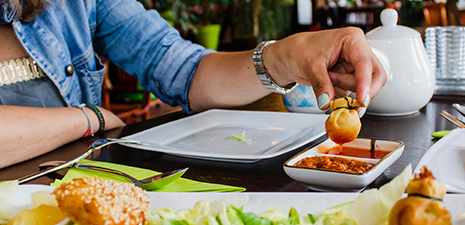If you struggle with eating or snacking on autopilot, mindful eating is a new approach you may want to consider. Learn the basics from Dr. Ellen Albertson.

9 Ways to Slow Down During Meals
Being mindful and more present during meals is a practice that’s becoming more popular lately, and with very good reasons. Mindful eating helps you pay attention and appreciate the food you eat.
Slowing down during meals is also key to sensing and responding to physiological hunger and satiety signals. Lack of awareness of appetite cues may lead to overeating and unwanted weight gain in the long run. On the other hand, learning to eat according to your appetite signals has been shown to benefit healthy weight maintenance.1
Mindful eating practices work best if we break them down into three parts: before, during, and after the meal. Although it may seem like a lot of work to put into the act of eating, over time it’ll be easier, and you’ll be able to reap the positive results. And you don’t have to do all these steps perfectly or even all at once when you’re first starting out. Try incorporating a few of them during one meal a day to start off with, and build from there. Gradually, you’ll learn to become more in tune with your body and eat according to what it really needs.
Here are some ways to help you slow down during meals and become a more mindful eater.
Before the Meal
- Minimize distractions: In order to be fully present during mealtimes, it is important to minimize distractions as much as possible. Turn off the TV, put down your phone, and close your laptop. Small distractions can make it difficult to listen to your body and be present. Also, sit down in a designated area for meals. It’s a lot harder to eat mindfully when you are standing up or eating on the run.
- Plate your meal with appropriate portion sizes: The MyPlate2 method is one of my favorite resources for food portions. It recommends that you use a 9" round plate, fill ½ of it with fruits and vegetables, ¼ with a protein source, and ¼ with a carbohydrate choice.
- Pause before taking your first bite: The act of pausing or stopping before your first bite allows your body to be more present during the meal. Notice what you’re about to eat. Take a moment to notice the colors, textures, and aromas of your meal. Feel gratitude for what you’re about to eat, and recognize that you’re nourishing and taking care of your body by feeding it.
During the Meal
- Chew each bite very well, and savor it: When we eat with distractions, we don’t actually taste the food we eat. The act of chewing allows our body to start the digestion process and be fully present during each bite. After each bite, put the fork down. This practice will help you to pay attention to the taste, textures, and flavors. Are the flavors mostly sweet, salty, savory, or spicy? When we’re not present during meals, we also don’t realize if we are enjoying the food we are eating. Ask yourself: Do I like what I’m eating? Why do I like it? What pleasant sensations or thoughts do these flavors evoke in me?
- Honor your fullness cues: Halfway through the meal, pause and check your fullness levels. Pushing past fullness can cause physical discomfort and isn’t honoring your body signals. Remember that you can always come back for seconds when you’re not satisfied.
- Remember that you don’t have to be a part of the “clean plate club”: You really don’t have to finish the whole plate if you already feel full. This just leads to less awareness of your appetite cues, plus an intake of unnecessary calories. For some people who were “trained” as children to “clean their plates,” this can be especially difficult. Try to gently remind yourself that it’s okay to leave food on your plate if you really can’t eat anymore.
After the Meal
- Think about what you just ate objectively, instead of judging: How do you feel: satisfied, still hungry, or too full? If you ate past the sensation of fullness, don’t judge yourself. Instead, act like your own detective and try to figure out why you felt the urge to continue eating. Take it as an opportunity to learn more about yourself and what makes you tick. If you notice you still feel physically hungry, explore the possibility that maybe the meal wasn’t enough.
- Check your emotions: Sometimes our appetites are related to stress or anxiety, regardless of portion size. If you’ve recognized that you’re full but still feel the need to eat, ask yourself what you’re emotionally feeling: boredom, stress, worry, anxiety, sadness, or any other emotion that is challenging for you to deal with. Try to practice non-food activities to help you relieve the emotional discomfort, such as breathing exercises, journaling, or meditation.
- Create a post-meal routine: If you tend to regularly feel urges to continue eating, even after the sensation of fullness, create a post-meal routine such as reading, taking a walk, doing yoga, chatting with a friend, or any other activity you find enjoyable that is not related to food. Give yourself time for the satiety signals to kick in, which can range from 10 to 30 minutes.
Remember that it takes time to change our habits and make new ones. Reprogramming eating habits is one of the most difficult tasks we can take on, so be gentle with yourself. No negative judgements allowed!
Start out slow, doing what you feel most comfortable with, and keep going from there. This will also help you build more confidence in yourself to continue creating more positive habits. When it comes to adopting healthy lifestyle habits, slow and steady is what really wins the race.
Rx Only. For the safe and proper use of Plenity or more information, talk to a healthcare professional, read the Patient Instructions for Use.
- de Bruin WE, Ward AL, Taylor RW, et al ‘Am I really hungry?’ A qualitative exploration of patients’ experience, adherence and behaviour change during hunger training: a pilot study BMJ Open 2019;9:e032248. doi: 10.1136/bmjopen-2019-032248
- https://www.choosemyplate.gov/






